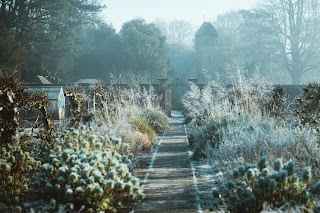Winter-Bloom
Somehow, I always missed how winter is in bloom. I guess because I live in a place where things go so dormant in the dark, cold months... Along the way, I failed to realize how much comes to life even when things seem so lifeless - how certain trees or shrubs look their finest and best when blanketed by snow-white or hung with ice or how brilliant their color against the sky-grey of the heavens. But a recent read in an english garden magazine caught my attention as multiple articles talked about "gardens that shine in the cold." Almost as if they exude a special kind of magic.
I was surprised to find that some people actually plan their whole gardening year around winter. They anticipate it and plant accordingly because they want their gardens to look their best when everything around is expected to look its worst. They select and prune and shape their trees and shrubs so that they become their own kind of artistic beauty - a canvas of dark hues and textures that give a feast for the eye in the dead of the season. And I'm starting to realize that how you get through winters of the soul is much the same: you must adjust your expectations and learn to prepare and view it in a new light.
One of the writers said something profound as she pointed out that it all comes down to "embracing the full cycle of a plant." That one can't fully embrace a winter garden unless you are okay with seeing the shrub or tree or bush in its barest form, watching it go from seed to germination to full bloom to seedhead. That you'll miss the charm of this season if you aren't embracing the natural look of a plant that has past its prime and is spent. Instead of ignoring it in its dormant state, learning how to observe and appreciate the stripped-down gorgeousness of something that is still giving beauty to the eye... just not in the way one might be looking.
These winter beauties are grounded in the subtle: subtle scents, reduced or refined colors, restrained charm that grabs the attention of anyone wiling to notice nuances instead of the bold. And while we are often used to getting up close to see the details of a summer rose or peony or dahlia, winter's garden gives you the perspective of distance - of stepping back and seeing the bigger picture. And perhaps this isn't all that unlike life itself: you can't just be up close and personal all the time, absorbed in the daily rhythms of routine and responsibility. Sometimes God gives us seasons of quiet dormancy to take stock of who we are and what we're about. Maybe there is hidden and missed opportunity in the calm of icy-sharp.
A winter garden also asks you to redefine your idea of perfect. In Spring or Summer, there is a certain look that people expect to see when they view a garden space: the colors have to blend a certain way, weeds are not welcome, everything must be in order and properly kept. But winter gardeners claim that there is something oddly appealing about a natural look. When all the leaves have fallen and the earth is going dormant and all that's left are some grasses and bushes and seedhead plants that can weather the cold, there is something attractive in it not mattering as much if the random weed pops up. There is a letting go of perfection allows one to soften hard edges, to get used to a calmer color palate that keeps its form all year long and offers some glimpse of life when the harshness of winter is pressing down... to remind the gardener or viewer that there is still something alive and growing even as the winds howl and the flakes fly and the temperature plummets.
When you are accustomed to only seeing things in bright-bloom, you miss what is growing and becoming right in front of you in the harsh times. If you're only wanting to prepare for the summer-warmth, you will struggle to notice what the winter-bloom is giving to you. You will see death where others are viewing life only slowed and more subtle. You will want to rip out what, in someone else's eyes, is a scene of beauty. You will point out imperfections where another sees it as perfectly imperfect. And maybe people themselves in their soul aren't all that much different...
Maybe some of us aren't born as much for the spring possibility or the summer fullness. Maybe some of us are made to give our own special beauty in more subtle ways that are only seen with distance and quiet-time. Maybe some of us were created to bring the soft message of hope in the winter's chill when some have forgotten that anything is growing at all... a reminder to them that the earth is still alive and so is their heart, even when the darkness and the icy-cold have done a job on them.
Berries hang bright-red from trees, dusted with a fresh snowfall in purest white. The dark-green of coniferous trees and various shrubs and bushes and the occasional flowering plants like amaryllis, which bloom only in winter's dead, help us see that it isn't that nothing is happening. We just don't know where to look. And maybe, all this time we've been rushing by, we've been losing touch with the beauty that even winter still affords us. Maybe too, we've been missing the beauty of someone's soul that beats much the same.
Winter still gives off its own loveliness if only we have eyes to see. People do, too. I say it's time we open up our eyes and ask for vision to see everything afresh.

Comments
Post a Comment